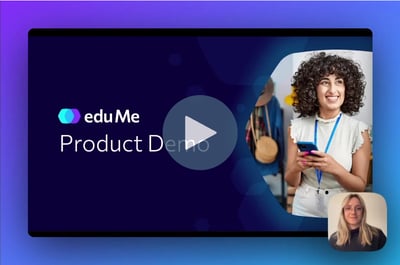Like many companies, you may have realised that corporate training and communication need to reflect how we work, where we work and how we consume information. You may have also concluded that mobile is the only way to reach your workforce. But how do you make sure this isn’t just another online training initiative that suffers from poor engagement and low completion rates? At eduMe, we’ve built up a fair bit of expertise in mobile learning, which we often get asked to share. So we recently published an insights paper, based on our experiences with clients.
Check out our top 10 takeaways:
1. Clearly communicate the value of your mobile platform
If your learners can’t see how a new training tool will help them, why would they use it? Build a consistent set of communications to show how the training will enable learners to crush their sales targets, improve their negotiations skills, deal better with customer complaints….you get the picture.
2. Make it easy to get started...and to keep learning
Learners will decide in 4-5 clicks whether the mobile learning platform is worth the effort. Map out the process of getting started - how many steps are involved? Test it out with a small group to find any sources of friction, and then get rid of as many as possible. Ensure that learners can stay logged into the mobile learning app or website once they’ve identified themselves through the initial activation process - they shouldn’t have to do this more than once.
3. Design your mobile learning for mobile
Mobile learning is not simply shrinking existing desktop e-learning to fit a smartphone screen. We’ve seen plenty of examples of this and it’s really awful. Really. Instead, think about what you and your learners do on your mobiles: you swipe, you tap, you click. Incorporate these functions to create an interactive and engaging mobile learning experience.
4. Replicate familiar mobile behaviours
Now that you’re thinking about mobile behaviours, what are the mobile apps that your learners use the most? Facebook, WhatsApp, dare we say Tinder? Replicate familiar actions from these apps to create an easy to use, intuitive interface. What could that look like? Scrolling through a newsfeed, swiping cards left or right, tapping conversation bubbles...
5. Use a light-hearted, conversational tone
The words ‘Corporate Training’ set off alarm bells for most people – they’re expecting something dull and boring. Use interactivity, a conversational style, and a dash of humour to challenge these perceptions.
6. Keep it concise, keep it relevant
In the words of Josh Bersin, “today’s employees are overwhelmed, distracted, and impatient”. This means that your learners will take 5-10 seconds to decide whether to proceed with training, based on whether it looks relevant and will fit into their busy schedules. In our experience, the sweet spot for a mobile training course is between 2 to 4 minutes long. And yes, this is micro-learning - we’ll talk more about that in # 8.
7. Use videos
We all love videos, so make sure your mobile and online learning initiatives incorporate them. The “keep it concise” rule applies here too: attention spans won’t stretch to more than 2 minutes. Use real life situations that your learners can relate to and improve knowledge retention by using on screen text and graphics to highlight main takeaways. Finally, add subtitles to make it easy for learners who don’t want to enable audio on a crowded train when they forgot their headphones.
8. Use micro-learning to make learning a daily habit
Micro-learning is more than a buzzword. It’s the idea that corporate training should reflect how we consume information - in short bursts, at the point of need, from our smartphones, on the District line. For micro-learning to be effective in terms of behaviour change and driving business results, it has to be done regularly. Josh Bersin provides a great explanation of micro-learning here (Yes, we’re big fans). So, provide snippets of useful information and short, relevant courses that your learners can dip into. When they check into their mobile learning platform, they should always find new, interesting content.
9. Encourage, and enable, ‘binge-learning’
We found that our learners were completing an average of more than 3 lessons at a time, so we adapted our learning design to this behaviour. Make it easy and compelling for people to keep going with their learning by lining up the next short lesson (think Netflix).
10. Experiment with notifications and elements of gamification
It’s natural that engagement wears off with time. Use your mobile learning app to send notifications to bring learners back, but bear in mind this can get annoying. Don’t be annoying. An open rate of 20% is a good achievement. Try out different frequency patterns and A/B test your messages. Notifications can also facilitate elements of gamification - for example, informing your learners of their progress vs. their peers, or letting them know the next level or trophy is only 1 lesson away.
Want to find out more about eduMe’s mobile LMS? Get Started






